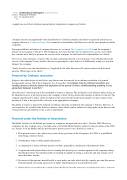Page 909 - (A) Mammoth (998pp)
P. 909
From: Graffiti Editions Ink/Designers studio@graffiti.biz Subject: Removal Of A Director
Date: 13 July 2014 22:16 To:
I suggest you send this to Michele requesting her resignation to negate any further
Company directors are appointed by the shareholders of a limited company and must be registered and listed as a company director at Companies House. It is common for shareholders and directors to be the same people in smaller companies.
The responsibilities and duties of company directors are set out in The Companies Act 2006 and the company’s Articles of Association (“Articles”). The Companies Act states that the role of a director is to act in a way which they consider most likely to promote the success of the company, for the benefit of its shareholders as a whole.
However, in some instances, it may be the case that a particular director is not acting in a way which promotes the success of the company. It may be that a director is ignoring his or her duties or is deliberately acting in a way that damages the company.
Clearly, in such a case, the shareholders or, if applicable, the other directors will want to remove the director in question. What steps can be taken?
Removal by Ordinary resolution
Subject to the other factors set out below, any director can be removed by an ordinary resolution of a general meeting under section 168 of the Companies Act. It says that “a company may by ordinary resolution at a meeting remove a director before the expiration of his period of office, notwithstanding anything in any agreement between it and him.”
“Special notice” must be given of the resolution to remove a director. The resolution is not effective unless notice of the intention to move it has been given to the company at least 28 days before the meeting at which it is moved. The company must then give notice of the resolution at the same time and in the same manner as it gives notice of the meeting or, if that is not practicable, advertise in an appropriate newspaper.
The ability to remove a director by ordinary resolution cannot be excluded by the company’s Articles. However, it can, in practice, be avoided if the Articles contain a clause which confers enhanced voting rights on the director who is being removed, provided he or she is also a shareholder.
Removal under the Articles of Association
The Model Articles are the default provisions for companies incorporated on or after 1 October 2009. However, companies are free to adopt, vary or exclude some or all of the Model Articles, subject to the provisions of the 2006 Act. Article 18 of the Model Articles provide that a person ceases to be a director as soon as:
1. That person ceases to be a director by virtue of any provision of the Companies Act 2006 or is prohibited from being a director by law
2. A bankruptcy order is made against that person
3. A composition is made with that person's creditors generally in satisfaction of that person's debts
4. A registered medical practitioner who is treating that person gives a written opinion to the company stating that that person has become physically or mentally incapable of acting as a director and may remain so for more than three months
5. By reason of that person's mental health, a court makes an order which wholly or partly prevents that person from personally exercising any powers or rights which that person would otherwise have
6. Notification is received by the company from the director that the director is resigning from office, and such


